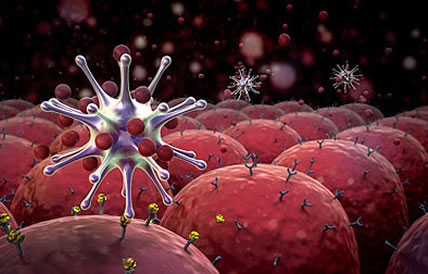|

by April McCarthy
February 3, 2014
from
PreventDisease Website
Spanish version
|
April McCarthy is a
community journalist playing an active role reporting
and analyzing world events to advance our health and
eco-friendly initiatives. |
It takes no more than 100 seconds for the body's immune cells to
identify and kill a cancer cell. Immune cells undergo ‘spontaneous’
changes on a daily basis that could lead to cancers if not for the
diligent surveillance of our immune system, Melbourne scientists
have found.

A research team from the
Walter and Eliza Hall Institute found
that the immune system was responsible for eliminating
potentially cancerous immune B cells in their early stages,
before they developed into B-cell lymphomas (also known as
non-Hodgkin's lymphomas).
The results of the study were
published today in the journal
Nature Medicine.
The immune system's basic task is to recognize "self" (the body's
own cells) and "nonself" (an antigen - a virus, fungus, bacterium,
or any piece of foreign tissue, as well as some toxins). To deal
with nonself or antigens, the system manufactures specialized cells
- white blood cells - to recognize infiltrators and eliminate them.
We all come into the world with some innate immunity.
As we interact with our environment, the
immune system becomes more adept at protecting us. This is called
acquired immunity.
Many mature white blood cells are highly specialized. The so-called
T lymphocytes (T stands for thymus-derived) have various functions,
among them switching on various aspects of the immune response, and
then (equally important) switching them off. Another lymphocyte, the
B cell, manufactures antibodies.
A larger kind of white cell, the
scavenger called the phagocyte (most notably the macrophage), eats
up all sorts of debris in tissue and the bloodstream, and alerts
certain T cells to the presence of antigens.
''The T-cells basically detect the
enemy and then throw grenades at the cancer cell until it blows
up,'' said immunologist Misty Jenkins from the Peter MacCallum
Cancer Centre.
T-cells are a type of white blood cell
that are key to the body's immune response.
Normally when a T-cell kills the target,
the only way you would know that the target has been hit or killed
is when it physically starts to die.
However the B-cells bind to a specific antigen and antibodies
against these antigens, thus performing the role of
antigen-presenting cells (APCs), and to develop into memory B
cells after activation by antigen interaction.
This immune surveillance accounts for what researchers at the
institute call the 'surprising rarity' of B-cell lymphomas in the
population, given how often these spontaneous changes occur.
The discovery could lead to the
development of an early-warning test that identifies patients at
high risk of developing B-cell lymphomas, enabling proactive
treatment to prevent tumors from growing.
All B-cells, whether healthy or cancerous, have on their surfaces a
proteins. To treat patients with the disease, the researchers need
to find ways to reprogram their T-cells to find the proteins and
attack B-cells carrying it.
Dr Axel Kallies, Associate Professor David Tarlinton,
Dr Stephen Nutt and colleagues made the discovery while
investigating the development of B-cell lymphomas.
Dr Kallies said the discovery provided an answer to why B-cell
lymphomas occur in the population less frequently than expected.
"Each and every one of us has
spontaneous mutations in our immune B cells that occur as a
result of their normal function," Dr Kallies said. "It is then
somewhat of a paradox that B cell lymphoma is not more common in
the population.
"Our finding that immune surveillance by T cells enables early
detection and elimination of these cancerous and pre-cancerous
cells provides an answer to this puzzle, and proves that immune
surveillance is essential to preventing the development of this
blood cancer."
B-cell lymphoma is the most common blood
cancer in Australia, with approximately 2800 people diagnosed each
year and patients with a weakened immune system are at a higher risk
of developing the disease.
The research team made the discovery while investigating how B cells
change when lymphoma develops.
"As part of the research, we
'disabled' the T cells to suppress the immune system and, to our
surprise, found that lymphoma developed in a matter of weeks,
where it would normally take years," Dr Kallies said.
"It seems that our immune system is
better equipped than we imagined to identify and eliminate
cancerous B cells, a process that is driven by the immune T
cells in our body."
Associate Professor Tarlinton said the
research would enable scientists to identify pre-cancerous cells in
the initial stages of their development, enabling early intervention
for patients at risk of developing B-cell lymphoma.
"In the majority of patients, the
first sign that something is wrong is finding an established
tumour, which in many cases is difficult to treat" Associate
Professor Tarlinton said.
"Now that we know B-cell lymphoma is
suppressed by the immune system, we could use this information
to develop a diagnostic test that identifies people in early
stages of this disease, before tumors develop and they progress
to cancer. There are already therapies that could remove these
'aberrant' B cells in at-risk patients, so once a test is
developed it can be rapidly moved towards clinical use."
|

